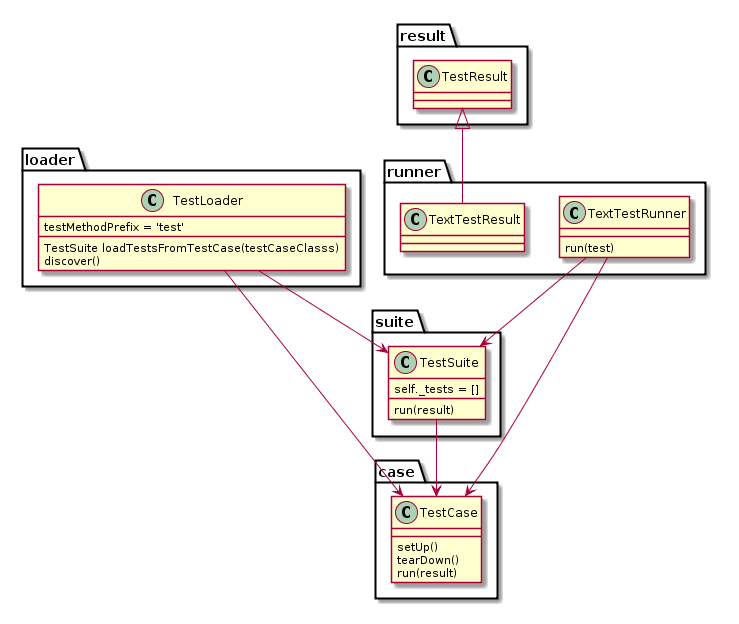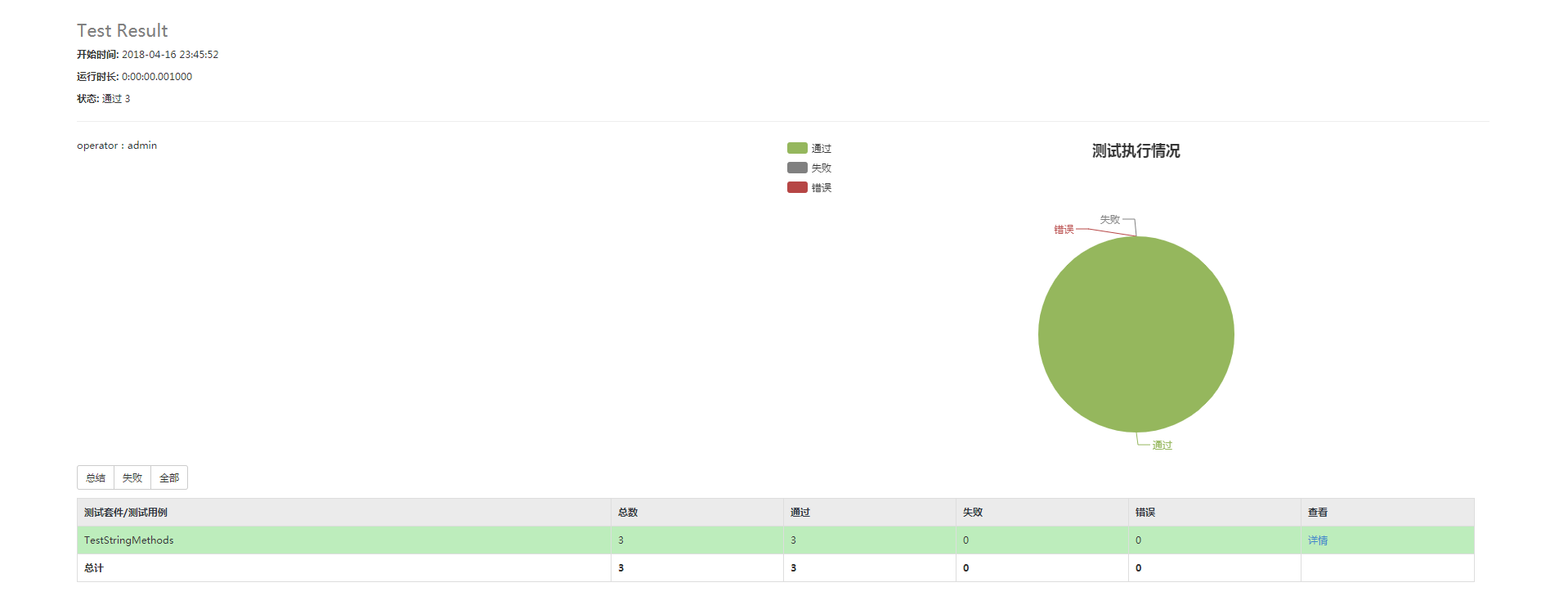Python3 Selenium自动化web测试 ==> 第一节 起始点之Python单元测试框架 unittest
前置步骤
Python版本:3.6.4
selenium版本:3.11.0
>>> import selenium >>> help(selenium)
IDE:Pycharm
学习目的
- 掌握Python版本的selenium自动化技能,对所学的知识总结,可以作为日后工作的参考;
- 对学习的Python脚本编码能力再磨练,实战中学习;
- 为后续的跳槽作准备,说难听点,不会编码的测试,去哪都没啥竞争力
正式步骤
Step1:unittest框架中最核心的4个概念:test fixture(测试固件)、test case(测试用例)、test suite(测试套件)、test runner(测试运行器)
运行工作图:

运行数据流:
- 一个TestCase的实例就是一个测试用例。什么是测试用例呢?就是一个完整的测试流程,包括测试前准备环境的搭建(setUp),执行测试代码(run),以及测试后环境的还原(tearDown)。元测试(unit test)的本质也就在这里,一个测试用例是一个完整的测试单元,通过运行这个测试单元,可以对某一个问题进行验证。
- 而多个测试用例集合在一起,就是TestSuite,而且TestSuite也可以嵌套TestSuite。
- TestLoader是用来加载TestCase到TestSuite中的,其中有几个loadTestsFrom__()方法,就是从各个地方寻找TestCase,创建它们的实例,然后add到TestSuite中,再返回一个TestSuite实例。
- TextTestRunner是来执行测试用例的,其中的run(test)会执行TestSuite/TestCase中的run(result)方法。测试的结果会保存到TextTestResult实例中,包括运行了多少测试用例,成功了多少,失败了多少等信息。
- 而对一个测试用例环境的搭建和销毁,是一个fixture。
简单示例:
import unittest class TestStringMethods(unittest.TestCase): def test_upper(self): self.assertEqual('foo'.upper(), 'FOO') def test_isupper(self): self.assertTrue('FOO'.isupper()) self.assertFalse('FFF'.isupper(),msg='wrong flag') def test_split(self): s = 'hello world' self.assertEqual(s.split(), ['hello', 'world']) # check that s.split fails when the separator is not a string with self.assertRaises(TypeError): s.split(2) if __name__ == '__main__': unittest.main()
运行结果:
F.. ====================================================================== FAIL: test_isupper (__main__.TestStringMethods) ---------------------------------------------------------------------- Traceback (most recent call last): File "F:/python_stack/python_autotest/demo.py", line 10, in test_isupper self.assertFalse('FFF'.isupper(),msg='wrong flag') AssertionError: True is not false : wrong flag ---------------------------------------------------------------------- Ran 3 tests in 0.001s FAILED (failures=1)
运行结果告诉我们:
1.测试用例执行后,结果顺序是随机排序;
2.测试用例以test为前缀;
3.如果想单独运行一个用例,点击相应的测试用例代码区域,右键点击运行相应的方法
4,运行测试套件可以点击run(alt+shift+F10)
Step2:test fixture之setUp() + tearDown() 和 setUpClass() 与 tearDownClass()
setUp() + tearDown() :在每个测试方法执行前以及执行后执行一次,setUp用来为测试准备环境,tearDown用来清理环境,准备之后的测试
setUpClass() 与 tearDownClass():在所有case执行之前准备一次环境,并在所有case执行结束之后再清理环境
实例代码:
import unittest class TestStringMethods(unittest.TestCase): @classmethod def setUpClass(cls): #只执行一次,在所有用例开始前执行,一般用来预制数据,也可以为下发自动化task初始化 print('setUpClass'+'\n') @classmethod def tearDownClass(cls): #只执行一次,在所用测试用例执行完毕后运行,一般用来清理测试环境 print('tearDownClass'+'\n') def setUp(self): # 每个用例都执行,在单个用例运行前执行 print('准备开始执行用例'+'\n') def tearDown(self): #每个用例都执行,在单个用例运行后执行 print('清理此用例的初始化'+'\n') def test_upper(self): self.assertEqual('foo'.upper(), 'FOO') print('test_upper'+'\n') def test_isupper(self): self.assertTrue('FOO'.isupper()) self.assertFalse('Foo'.isupper(),msg='wrong flag') print('test_isupper'+'\n') def test_split(self): s = 'hello world' self.assertEqual(s.split(), ['hello', 'world']) # check that s.split fails when the separator is not a string with self.assertRaises(TypeError): s.split(2) print('test_split'+'\n') if __name__ == '__main__': unittest.main()
运行结果:
... ---------------------------------------------------------------------- Ran 3 tests in 0.000s OK setUpClass 准备开始执行用例 test_isupper 清理此用例的初始化 准备开始执行用例 test_split 清理此用例的初始化 准备开始执行用例 test_upper 清理此用例的初始化 tearDownClass
Step3:test suite 的使用方法
test suite(测试套件)的作用是批量运行多个测试用例,此外还可以做的操作是:
- 调整测试用例执行顺序
- 多个test suite中的test case执行
- (暂留)
实例1: 同一个文件中不同测试类中的测试用例加载到测试套件中
import unittest class TestStringMethods(unittest.TestCase): def test_upper(self): self.assertEqual('foo'.upper(), 'FOO') def test_isupper(self): self.assertTrue('FOO'.isupper()) self.assertFalse('Foo'.isupper()) def test_split(self): s = 'hello world' self.assertEqual(s.split(), ['hello', 'world']) # check that s.split fails when the separator is not a string with self.assertRaises(TypeError): s.split(2) class MathMethods(unittest.TestCase): def test_sum(self): s = 'Python' self.assertNotEquals('python',s.islower()) if __name__ == '__main__': testcase1 = unittest.TestLoader().loadTestsFromTestCase(MathMethods) testcase2 = unittest.TestLoader().loadTestsFromTestCase(TestStringMethods) suite = unittest.TestSuite([testcase1,testcase2]) #verbosity的参数为0/1/2,2的回显结果最详细 unittest.TextTestRunner(verbosity=2).run(suite)
运行结果:
test_sum (__main__.MathMethods) ... ok test_isupper (__main__.TestStringMethods) ... ok test_split (__main__.TestStringMethods) ... ok test_upper (__main__.TestStringMethods) ... ok ---------------------------------------------------------------------- Ran 4 tests in 0.001s OK
实例2:按照特定顺序执行用例
import unittest class TestStringMethods(unittest.TestCase): def test_upper(self): self.assertEqual('foo'.upper(), 'FOO') print('test_upper') def test_isupper(self): self.assertTrue('FOO'.isupper()) self.assertFalse('Foo'.isupper()) print('test_isupper') def test_split(self): s = 'hello world' self.assertEqual(s.split(), ['hello', 'world']) # check that s.split fails when the separator is not a string with self.assertRaises(TypeError): s.split(2) print('test_split') if __name__ == '__main__': print('单个单个添加测试用例') suite = unittest.TestSuite() suite.addTest(TestStringMethods('test_upper')) suite.addTest(TestStringMethods('test_split')) suite.addTest(TestStringMethods('test_isupper')) runner = unittest.TextTestRunner() runner.run(suite) print('同时添加多个测试用例') suite1 = unittest.TestSuite() suite1.addTests([TestStringMethods('test_split'),TestStringMethods('test_isupper'),TestStringMethods('test_upper')]) runner2 = unittest.TextTestRunner() runner2.run(suite1)
Step4: 忽略某个测试用例不执行,也就是跳过某个用例不执行
import unittest import sys class TestStringMethods(unittest.TestCase): @unittest.skipIf('F'=='f','不满足判断条件就执行') def test_upper2(self): self.assertEqual('foo'.upper(), 'FOO') print('test_upper2') @unittest.skipIf('F'=='f'.upper(),'满足判断条件就不执行') def test_upper(self): self.assertEqual('foo'.upper(), 'FOO') print('test_upper') @unittest.skip('忽略此用例不执行') def test_isupper(self): self.assertTrue('FOO'.isupper()) self.assertFalse('Foo'.isupper()) print('test_isupper') #skipUnless表示如果系统名称是linux,用例就忽略执行,提示用户使用win,sys.platform返回操作系统平台名称 #Python startswith() 方法用于检查字符串是否是以指定子字符串开头 @unittest.skipUnless(sys.platform.startswith('linux'),'we need windows') def test_split(self): s = 'hello world' self.assertEqual(s.split(), ['hello', 'world']) # check that s.split fails when the separator is not a string with self.assertRaises(TypeError): s.split(2) print('test_split') if __name__ == '__main__': suite1 = unittest.TestSuite() suite1.addTests([TestStringMethods('test_upper2'),TestStringMethods('test_split'),TestStringMethods('test_isupper'),TestStringMethods('test_upper')]) runner2 = unittest.TextTestRunner(verbosity=2) runner2.run(suite1)
运行结果:
test_upper2 (__main__.TestStringMethods) ... ok test_upper2 test_split (__main__.TestStringMethods) ... skipped 'we need windows' test_isupper (__main__.TestStringMethods) ... skipped '忽略此用例不执行' test_upper (__main__.TestStringMethods) ... skipped '满足判断条件就不执行' ---------------------------------------------------------------------- Ran 4 tests in 0.001s OK (skipped=3)
Step5:将运行结果保存到文件中
import unittest import sys class TestStringMethods(unittest.TestCase): @unittest.skipIf('F'=='f','不满足判断条件就执行') def test_upper2(self): self.assertEqual('foo'.upper(), 'FOO') print('test_upper2') @unittest.skipIf('F'=='f'.upper(),'满足判断条件就不执行') def test_upper(self): self.assertEqual('foo'.upper(), 'FOO') print('test_upper') @unittest.skip('忽略此用例不执行') def test_isupper(self): self.assertTrue('FOO'.isupper()) self.assertFalse('Foo'.isupper()) print('test_isupper') #skipUnless表示如果系统名称是linux,用例就忽略执行,提示用户使用win,sys.platform返回操作系统平台名称 #Python startswith() 方法用于检查字符串是否是以指定子字符串开头 @unittest.skipUnless(sys.platform.startswith('linux'),'we need windows') def test_split(self): s = 'hello world' self.assertEqual(s.split(), ['hello', 'world']) # check that s.split fails when the separator is not a string with self.assertRaises(TypeError): s.split(2) print('test_split') if __name__ == '__main__': suite1 = unittest.TestSuite() suite1.addTests([TestStringMethods('test_upper2'),TestStringMethods('test_split'),TestStringMethods('test_isupper'),TestStringMethods('test_upper')]) with open('result.txt','a+',encoding='utf-8') as f: runner2 = unittest.TextTestRunner(stream=f,verbosity=2) runner2.run(suite1)
方法就是上述代码所示
Step6: 使用HTMLTestRunner生成HTML格式测试报告
测试脚本:
import unittest import os from HTMLTestRunner import HTMLTestRunner class TestStringMethods(unittest.TestCase): def test_upper(self): self.assertEqual('foo'.upper(), 'FOO') print('test_upper') def test_isupper(self): self.assertTrue('FOO'.isupper()) self.assertFalse('Foo'.isupper()) print('test_isupper') def test_split(self): s = 'hello world' self.assertEqual(s.split(), ['hello', 'world']) # check that s.split fails when the separator is not a string with self.assertRaises(TypeError): s.split(2) print('test_split') if __name__ == '__main__': report = os.path.join('D:/Python36/report/report.html') suite1 = unittest.TestSuite() suite1.addTests([TestStringMethods('test_split'),TestStringMethods('test_isupper'),TestStringMethods('test_upper')]) with open(report,'wb') as f: runner2 = HTMLTestRunner(stream=f,title='Test Result',description='operator:admin',verbosity=2) runner2.run(suite1)
测试结果:

HTMLTestRunner脚本来自:https://blog.csdn.net/huilan_same/article/details/77944829
难点分析:
1. Python3很多测试类不支持,没有Python2那么好找解决办法
2. 效率太慢,明天继续
学习总结:
磨磨蹭蹭终于开始做自己想做的事情了,希望半个月到一个月内,可以输出stepbystep的测试步骤,而且是Python3脚本,挺有意思的,就是公司没有外网,坑啊
参考资料:
https://docs.python.org/3.6/library/unittest.html#
https://blog.csdn.net/huilan_same/article/details/52944782



 浙公网安备 33010602011771号
浙公网安备 33010602011771号